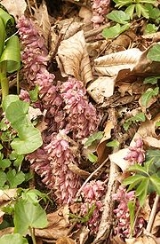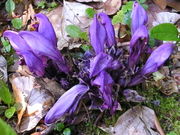
Toothwort
Encyclopedia
Toothwort is a small genus of five to seven species of flowering plant
s, native to temperate Europe
and Asia
. They are parasitic plant
s on the roots of other plants, and are completely lacking chlorophyll
. They are classified in the family
Orobanchaceae
. In addition, Cardamine concatenata
is also called toothwort.
The tootworth is a protocarnivorous plant
. Most of the plant consists of a branched whitish underground stem closely covered with thick fleshy colourless leaves, which are bent over so as to hide the under surface; irregular cavities communicating with the exterior are formed in the thickness of the leaf. On the inner walls of these chambers are stalked hairs, which when stimulated by the touch of an insect send out delicate filaments by means of which the insect is killed and digested.

In Pavel Ivanovich Melnikov
's "In the Forests" a Russian wise woman (znakharka) calls this plant Peter's Cross and says it protects against devils but only if collected with a prayer to God.
Flowering plant
The flowering plants , also known as Angiospermae or Magnoliophyta, are the most diverse group of land plants. Angiosperms are seed-producing plants like the gymnosperms and can be distinguished from the gymnosperms by a series of synapomorphies...
s, native to temperate Europe
Europe
Europe is, by convention, one of the world's seven continents. Comprising the westernmost peninsula of Eurasia, Europe is generally 'divided' from Asia to its east by the watershed divides of the Ural and Caucasus Mountains, the Ural River, the Caspian and Black Seas, and the waterways connecting...
and Asia
Asia
Asia is the world's largest and most populous continent, located primarily in the eastern and northern hemispheres. It covers 8.7% of the Earth's total surface area and with approximately 3.879 billion people, it hosts 60% of the world's current human population...
. They are parasitic plant
Parasitic plant
A parasitic plant is one that derives some or all of its sustenance from another plant. About 4,100 species in approximately 19 families of flowering plants are known. Parasitic plants have a modified root, the haustorium, that penetrates the host plant and connects to the xylem, phloem, or...
s on the roots of other plants, and are completely lacking chlorophyll
Chlorophyll
Chlorophyll is a green pigment found in almost all plants, algae, and cyanobacteria. Its name is derived from the Greek words χλωρος, chloros and φύλλον, phyllon . Chlorophyll is an extremely important biomolecule, critical in photosynthesis, which allows plants to obtain energy from light...
. They are classified in the family
Family (biology)
In biological classification, family is* a taxonomic rank. Other well-known ranks are life, domain, kingdom, phylum, class, order, genus, and species, with family fitting between order and genus. As for the other well-known ranks, there is the option of an immediately lower rank, indicated by the...
Orobanchaceae
Orobanchaceae
Orobanchaceae, the broomrape family, is a family of flowering plants of the order Lamiales, with about 90 genera and more than 2000 species. Many of these genera were formerly included in the family Scrophulariaceae sensu lato...
. In addition, Cardamine concatenata
Cardamine concatenata
The Cutleaf Toothwort, Crow's Toes, Pepper Root, Purple-flowered Toothwort is a flowering plant in Brassicaceae. It owes its name to the tooth-like appearance of its rhizome. It is a perennial plant woodland wildflower native to eastern North America...
is also called toothwort.
The tootworth is a protocarnivorous plant
Protocarnivorous plant
A protocarnivorous plant , according to some definitions, traps and kills insects or other animals but lacks the ability to either directly digest or absorb nutrients from its prey like a carnivorous plant...
. Most of the plant consists of a branched whitish underground stem closely covered with thick fleshy colourless leaves, which are bent over so as to hide the under surface; irregular cavities communicating with the exterior are formed in the thickness of the leaf. On the inner walls of these chambers are stalked hairs, which when stimulated by the touch of an insect send out delicate filaments by means of which the insect is killed and digested.

- Common Toothwort (Lathraea squamariaLathraea squamariaCommon Toothwort is a species of Toothwort.It is parasitic on the roots of hazel and alder, occasionally on beech, in shady places such as hedge sides...
) is parasitic on the roots of hazelHazelThe hazels are a genus of deciduous trees and large shrubs native to the temperate northern hemisphere. The genus is usually placed in the birch family Betulaceae, though some botanists split the hazels into a separate family Corylaceae.They have simple, rounded leaves with double-serrate margins...
and alderAlderAlder is the common name of a genus of flowering plants belonging to the birch family . The genus comprises about 30 species of monoecious trees and shrubs, few reaching large size, distributed throughout the North Temperate Zone and in the Americas along the Andes southwards to...
, occasionally on beechBeechBeech is a genus of ten species of deciduous trees in the family Fagaceae, native to temperate Europe, Asia and North America.-Habit:...
, in shady places such as hedge sides. Lathraea squamaria is widespread in Europe. - Purple Toothwort (Lathraea clandestina) grows on the roots of alder, poplarPoplarPopulus is a genus of 25–35 species of deciduous flowering plants in the family Salicaceae, native to most of the Northern Hemisphere. English names variously applied to different species include poplar , aspen, and cottonwood....
and willowWillowWillows, sallows, and osiers form the genus Salix, around 400 species of deciduous trees and shrubs, found primarily on moist soils in cold and temperate regions of the Northern Hemisphere...
. It differs in the dark purple flowers being produced one on each stem. Purple Toothwort grows in Middle and South Europe: Western Belgium, Western and Central France and Northern Spain, and locally in Central Italy. Elsewhere, especially in England, the plant is locally acclimated in parks and old gardens. - Rhodope Toothwort (Lathraea rhodopaea) is common for Rhodope MountainsRhodope MountainsThe Rhodopes are a mountain range in Southeastern Europe, with over 83% of its area in southern Bulgaria and the remainder in Greece. Its highest peak, Golyam Perelik , is the seventh highest Bulgarian mountain...
and RilaRilaRila is a mountain range in southwestern Bulgaria and the highest mountain range of Bulgaria and the Balkans, with its highest peak being Musala at 2,925 m...
.
In Pavel Ivanovich Melnikov
Pavel Ivanovich Melnikov
Pavel Ivanovich Melnikov was a Russian writer, known for his opera magna In the Forests and On the Hills, which describe the unique life of Transvolga and its dialects....
's "In the Forests" a Russian wise woman (znakharka) calls this plant Peter's Cross and says it protects against devils but only if collected with a prayer to God.

